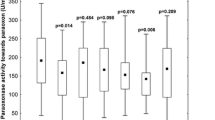Summary
Pericardial fluid paraoxonase activity was compared with 3 biochemical markers of atherosclerosis (HDL, LDL/HDL ratio and Apolipoprotein A-1) and a significant association was found. When the paraoxonase activity in pericardial fluid samples was separated into 2 groups according to the degree of coronary atherosclerosis (slight and severe), most of the cases showing low levels of paraoxonase activity also showed severe coronary atherosclerosis. In addition, paraoxonase activity in pericardial fluid was found to be statistically correlated with HDL levels, which agrees with the results reported in serum.
Zusammenfassung
Die Paraoxonase-Aktivität in Perikard-Flüssigkeit wurde mit drei biochemischem Markern der Arteriosklerose (HDL, LDL/HDL-Verhältnis und Apolipoprotein A-1) vergleichen. Hierbei fand sich eine signifikante Assoziation. Wenn die Paraoxonase-Aktivität in Perikardsflüssigkeitsproben in zwei Gruppen unterteilt wurde, entsprechend dem Grad der koronaren Atherosklerose (leicht und schwer), zeigten die meisten der Fälle mit geringen Spiegeln von Paraoxonase-Aktivität gleichzeitig eine schwere koronare Atherosklerose. Zusätzlich wurde gefunden, daß die Paraoxonase-Aktivität in Perikardflüssigkeit statistich korreliert mit den HDL-Spiegeln, was mit den für das serum berichteten Ergebnisse übereinstimmt.
Similar content being viewed by others
References
Baker G de, Rossenen M, Deslypere JP (1982) Discriminative value of lipids and apolipoproteins in coronary heart disease. Atherosclerosis 42:197–203
Buja LM, Willerson JT (1991) The role of coronary artery lesions in ischemic heart disease: insights from recent clinico-pathologic, coronary angiographic and experimental studies. In: Virmani R, Atkinson JB, Fenoglio JJ (eds) Cardiovascular pathology. WB Saunders, Philadelphia, pp 42–60
Castelli WP, Doyle JT, Gordon T, Hames CG, Hjortland MC, Hulley SB, Kagan A, Zukel WJ (1977) HDL-cholesterol and other lipids in coronary heart disease-the comparative lipoprotein phenotyping study. Circulation 55:767–772
Friedewald WT, Levy RI, Fredrickson DS (1972) Estimation of the concentration of low-density lipoprotein cholesterol in plasma, without the use of the preparative ultracentrifuge. Clin Chem 18: 499–502
Hernandez AF, Pla A, Valenzuela A, Gil F, Villanueva E (1992) Characterization of paraoxonase activity in pericardial fluid. Usefulness as a marker of coronary disease. 2nd International Meeting on Esterases hydrolysing organo-phosphorus compounds. Salsomaggiore, Italy, April 1992, Abstract P 17
Hougen HP, Valenzuela A, Lachica E, Villanueva E (1992) Sudden cardiac death: a comparative study of morphological, histochemical and biochemical methods. Forensic Sci Int 52:161–169
Lipid Research Clinics Program: Manual of laboratory Operations (1974) 1. Lipid and Lipoprotein analysis. US Department of Health, Education and Welfare, Publication (NIH), Bethesda, pp 72–628
Luna A, Carmona A, Villanueva E (1983) The postmortem determination of CK isoenzymes in the pericardial fluid in various causes of death. Forensic Sci Int 22:23–30
Mackness MI (1989a) Possible medical significance of human serum ‘A’-esterases. In: Reiner E, Aldridge WN, Hosking FCG (eds) Enzymes hydrolysing organophosphorus compounds. Ellis Horwood, Chichester, pp 202–213
Mackness MI (1989b) ‘A’-esterases. Enzymes looking for a role? Biochem Pharmacol 38:385–390
Mackness MI, Hallam SD, Peard T, Warner S, Walker CH (1985) The separation of sheep and human serum ‘A’-esterase activity into the lipoprotein fraction by ultracentrifugation. Comp Biochem Physiol 82B:675–677
McElveen J, Mackness MI, Colley CM, Peard T, Warner S, Walker CH (1986) Distribution of paraoxon hydrolytic activity in the serum of patients after myocardial infarction. Clin Chem 32:671–673
Miller GJ, Miller NE (1975) Plasma high density lipoprotein concentration and development of ischemic heart disease. Lancet 1: 16–19
Reiner E, Radic Z (1985) Method for measuring human plasma paraoxonase activity. Course on analytical procedures for assesment of exposure to organophosphorus pesticides. Manual of Analytical Methods, Cremona (Italy), pp 62–70
Valenzuela A, Hougen HP, Villanueva E (in press) Determination of lipoproteins and apolipoproteins in pericardial fluid: its applications to the postmortem diagnosis of sudden death. International Study Group of Sudden Unexpected Death (ISNUD) (ed). Workshop of Sudden Cardiac Death, Budapest
Virmani R, Ursell PC, Fenoglio JJ (1991) Examination of the heart. In: Virmani R, Atkinson JB, Fenoglio JJ (eds) Cardiovascular pathology. WB Saunders, Philadelphia, pp 1–20
Author information
Authors and Affiliations
Rights and permissions
About this article
Cite this article
Hernandez, A.F., Plat, A., Valenzuela, A. et al. Paraoxonase activity in human pericardial fluid: Its relationship to coronary artery disease. Int J Leg Med 105, 321–324 (1993). https://doi.org/10.1007/BF01222115
Received:
Revised:
Issue Date:
DOI: https://doi.org/10.1007/BF01222115




